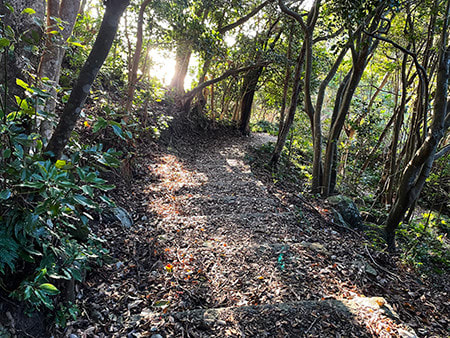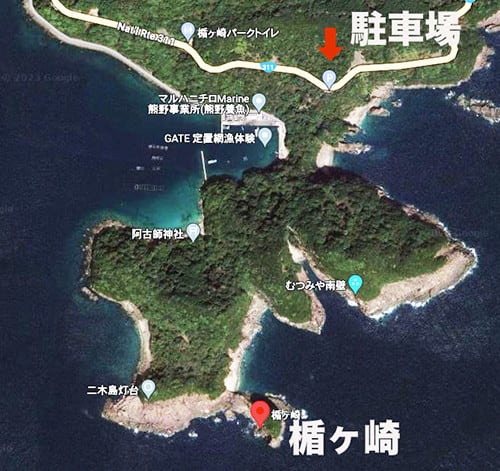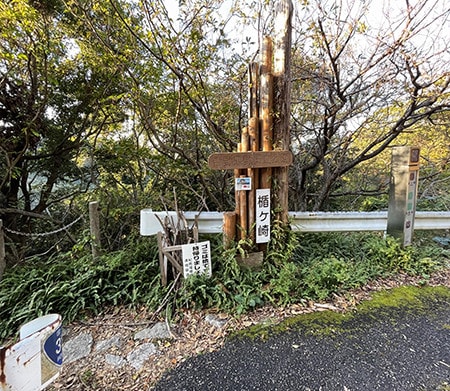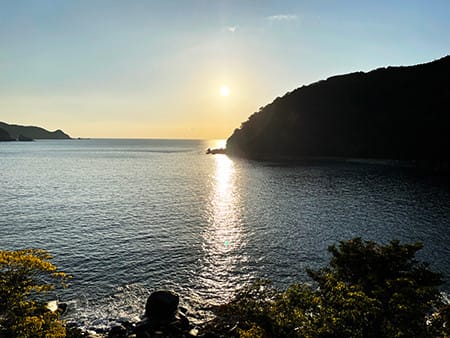


さて北海道から熊野のひとつの象徴としての楯ヶ崎への道。往古の神武東征の重要な故地であり、その後の中世での上皇たちによる「熊野詣」でも、当然行脚したことが考えられる。そういった「高名」な場所なので現代においては、相当「観光開発」されているものと漠然と想像していた。
しかし交通状況を調べるほどに熊野地域全体としてあまり利便性は高くはないことは薄々感じていた。それでもそれなりに開発されているものと思い込んでいた。前日宿泊した旅宿で「楯ヶ崎に行くのです」と申告したときの地元の人としての反応も意外そうであり、「ん?」とは思っていた。
ということで翌朝、クルマで30分ほど走って国道311号線の脇の「楯ヶ崎」駐車場に。最初は「あ、なんかちっちゃい駐車場があるな」とは思ったが、あまりな意外さで通り過ぎてしまった。そこから数分走ったら、反対側車線側にそこそこの駐車場。しかし、高名な観光スポットという刷り込みがあったのでそこもスルーしてさらに先へ向かった。行けども行けどもなにもない・・・。
「そうすると・・・」と、ようやく「観光地」概念への疑念が湧いてきて引き返すことにした。そこまで人影も見えなかったのだけれど、ようやく地元の方が早朝散歩されているのとすれ違うことができて楯ヶ崎について尋ねることができた。・・・あの「ちっちゃい駐車場」が目的のスポットだという。目的の楯ヶ崎はそこから山道の自然道を片道1.9km歩いた先にあるのだと判明。
その段階でようやく、この紀伊半島・熊野地域という実像が感得できはじめてきた。
事前にはこの楯ヶ崎探訪についての安部龍太郎の「半島をゆく」を読んでいたのだけれど、その記述以上に「北海道っぽい」ことがわかってきてしまったのですね。安倍さんはわたしより3つほど年下だけれど、体力的にかなりキツかったと記述されていた。「あれはホントだったのか」という迂闊な気付き(笑)。
まぁそれでも普段から早朝散歩で往復4km程度は札幌の円山周辺地域を歩いているので、体力的には問題はない。よし行くぞ。

この山道はまことに自然そのまま、リアス式海岸地形がそのまま残されていて、起伏と変化に満ちている。途中には湾入りして海岸に出る。そこに「阿古師神社」があって、その機縁も知っているので、参拝させていただいたあと、さらに半島部の山岳地形のなかに分け入っていく。
ほぼ無心で道標のままに歩いていて、ふと気付いたら野生のシカの後ろ姿と5-6m至近で遭遇。
森の中での突然の遭遇であります。あまりに咄嗟だったのでスマホ写真にまでこころが回らなかった。ただ気付いてカメラを向けたら、シカは早々に気付いて去って行ったことでしょう。この遭遇はまったくの一瞬の静寂なイキモノ同士の出会い。
シカの方でもこちらに気付かなかったようで、かれはかれの棲息する普段の環境の中で、静寂な心理のままに自然と一体になって呼吸していると感じた。札幌円山で出会う野生動物はリスや野鳥などで、ここまで大型の動物と出会うことはない。もしあるとすればそれはヒグマ。札幌以外ではクルマに乗っていてシカと遭遇することはあるけれど、こちらもカラダひとつだけの素肌感覚で遭遇するのははじめて。
こちらが「お邪魔」していることは明らかだけれど、かれがわたしに気付かないようには、この時わたしも自然と無心に同期していたのだろうかと、なぜか少しうれしかった。自分でも不思議な心理ですね。

そして楯ヶ崎、熊野の「地域の空気感」がこのとき一気にカラダに染み込んで来た。
English version⬇
4 km of forest road from the parking lot by the national road to Tategasaki [Imperial Mythology and Kumano Trip-6].
Due to a spur-of-the-moment encounter, I was unable to photograph the deer in the forests of Kumano. The deer I encountered in the back were quite naturally divine. ...
The road from Hokkaido to Tategasaki is one of the symbols of Kumano. It was an important place for the ancient expedition of the ancient Japanese emperor Jinmu to Kumano, and it is thought that the emperors of the Middle Ages naturally traveled to Kumano on their pilgrimages. Since it is such a "famous" place, I had vaguely imagined that it had been developed as a tourist destination in modern times.
However, the more I investigated the traffic situation, the more I realized that the Kumano area as a whole was not very convenient. Even so, I assumed that the area had been developed to a certain extent. When I told the inn where I had stayed the day before that I was going to Tategasaki, the reaction of the locals was not surprising. I had thought so.
So the next morning, I drove 30 minutes to the "Tategasaki" parking lot off Route 311. At first I thought, "Oh, there is a tiny parking lot," but I passed by it because it was so unexpected. After driving for a few minutes, I found a parking lot on the opposite side of the road. However, I had an impression that it was a well-known tourist spot, so I passed it and headed further on. I kept going and going, but nothing.
I finally began to doubt the concept of a "tourist spot," and decided to turn around. I didn't see any people, but finally I passed a local walking early in the morning and he asked me about Tategasaki. He told me that the "tiny parking lot" was the spot I wanted to visit. It turned out that our destination, Tategasaki, was 1.9 km away from there on a mountain nature trail.
At this point, I finally began to get a sense of the Kii Peninsula and the Kumano area.
I had read Ryutaro Abe's book, "Peninsula on the Way," about his visit to Tategasaki, but it turned out to be even more "Hokkaido-like" than Abe's description. Abe is about three years younger than I am, but he described the trip as physically demanding. I realized that I had been careless and wondered if it was true (laugh).
But I usually take an early morning walk of about 4 km round trip in the Maruyama area of Sapporo, so I have no problem physically. So, I'm going to go.
This mountain road is truly natural, with the rias coastline remaining as it is, full of ups and downs and changes. The path leads to a bay and then to the coast. There is a shrine called "Akoji Shrine" there, which I know the connection to, so after paying my respects, I continued on into the mountainous terrain of the peninsula.
I was walking almost mindlessly, following the signposts, when I suddenly realized that I had encountered the back of a wild deer at a distance of 5 to 6 meters from me.
It was a sudden encounter in the forest. It was so sudden that I didn't even think to take a picture with my phone. If I had just noticed it and pointed my camera at it, the deer would have noticed it and gone away. This encounter was a totally momentary encounter between two quiet creatures.
Even the deer did not seem to notice us, and I felt that he was breathing as one with nature in his usual habitat, with a tranquil mind. Wild animals encountered in Maruyama are squirrels, wild birds, etc., and we never encounter such large animals. If there is such a thing, it is a brown bear. Outside of Sapporo, I have encountered deer while riding in a car, but this was the first time for me to encounter a deer with only my body against its skin.
It was obvious that I was "intruding" on him, but for some reason I was a little happy, wondering if I had been in sync with nature and mindless, as if he had not noticed me at the time. It's a strange psychology even for me.
And the "local atmosphere" of Tategasaki and Kumano soaked into my body at once.



















